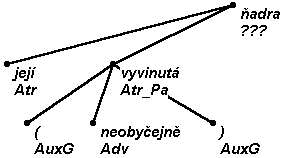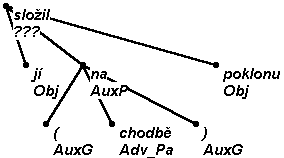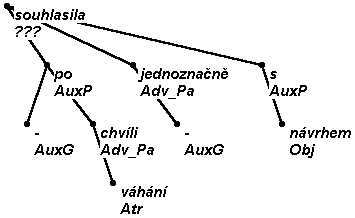In the first part, Specification of parenthesis, parenthesis and its types are specified, followed (in Representation of parenthesis) by a description of its representation in the tree structure and by a short specification of the distinction between parenthesis and apposition (in The borderline between parenthesis and apposition).
The next four parts are devoted to the four types of parenthesis: Representation of AuxY_Pa deals with particles that relate to the whole sentence; An independent sentential form (containing a predicate) Pred_Pa (part Representation of Pred_Pa) describes parenthesis that includes a predicate of its own but is not syntactically incorporated into the sentence; a parenthesis that is syntactically incorporated into the sentence, be it the case that it includes a predicate (it has a form of an embedded clause) or is a simple sentence part is described in Representation of <afun>_Pa. Section Representation of ExD_Pa includes instructions for other kinds of parenthesis that are not covered by the previous sections (either a predicate is missing in the paranthesis, or it is a vocative or an independent sentence part).
Semantically, parenthesis concerns an additional adjunction of a remark to the statement included in the sentence. The speaker usually uses parenthesis to explain something, to add some remarks, to express his/her emotions, to apologize, to refer to something, etc.
From the formal point of view, the necessary condition for the assignement of afun with the suffix _Pa is a graphic separation marking - by brackets, dashes, commas. If this condition is not fulfilled, a different afun should be assigned. E.g. in the sentence musím se, bohužel, omluvit (I must, unfortunately, apologize) the word bohužel (unfortunately) gets afun AuxZ_Pa, while in musím se bohužel omluvit it gets afun AuxY.
There are four possible assignments of afuns, according to the following four possible types of parenthesis:
-
If a particle without a graphic separation mark got afun AuxY, it gets - when graphically separated - AuxY_Pa (see A 'frozen' parenthesis AuxY_Pa and Particles pertaining to the whole utterance).
-
In case parenthesis does not violate the sentence structure, it is assigned an afun composed of the value of its function in the sentence (Adv, Atr, ...) and the suffix _Pa and it is suspended in the place where it belongs (see A syntactically incorporated sentence part with <afun>_Pa).
-
If the parenthesis has a form of a whole sentence (with a predicate) and it does not fit syntactically into the sentence structure, it gets afun Pred_Pa and it is suspended under the predicate of that clause into which it is embedded (see An independent sentential form (containing a predicate) Pred_Pa).
-
The rest of the cases of parenthesis are assigned afun ExD_Pa (this concerns the case in which a predicate is missing and some further cases described in A syntactially non-incorporated sentence part or sentential form; ellipsis; an independent sentence part; vocative; interjection Exd_Pa).
The graphic symbols separating a parenthesis are sisters suspended under the governing node of the parenthesis:
As a rule, prepositions and subordinating conjunctions are not assigned the sufix _Pa. If they govern a parenthesis, they get their usual afun AuxP or AuxC, and the suffix _Pa is assigned to the node that is suspended on them.
A parenthesis may consist of more than a single member; in such a case the individual parts of the parenthesis are suspended side by side and the separating symbols are daughters of the outer ones.
With nouns: the condition for the assignment of apposition is the identity of the (case) forms, or abbreviations:
If the cases differ, mostly parenthesis is concerned:
As mentioned above in part Specification of apposition, in case of adverbials the condition of the identity of cases need not be obeyed, cf. the apposition relation in


